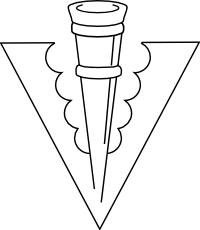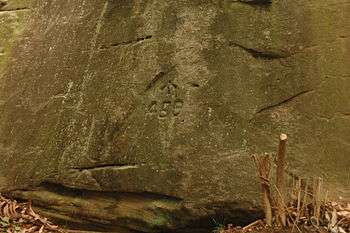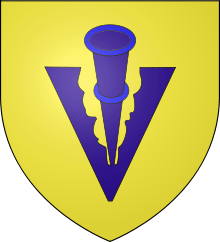Broad arrow

A broad arrow (of which a pheon is a variety) is a type of arrow with a typically flat barbed head. It is a symbol used traditionally in heraldry, most notably in England, and later by the United Kingdom Government to mark government property.
Use in heraldry
The broad arrow as a heraldic device has two tapering blades, known as barbs. When these barbs are engrailed on the inside, it is called a pheon. Woodward's A Treatise on Heraldry: British and Foreign with English and French Glossaries, makes the following distinction between the broad arrow and pheon: "A BROAD ARROW and a PHEON are represented similarly, except that the Pheon has its inner edges jagged, or engrailed."[1] Parker's A Glossary of Terms Used in Heraldry states, "A broad arrow differs somewhat... and resembles a pheon, except in the omission of the jagged edge on the inside of the barbs."[2]
The pheon, the engrailed broad arrow, occurs in heraldry in the arms of the Sidney and Coates families, and hence in the arms of Sidney Sussex College, Cambridge. The college's newsletter for alumni is also called Pheon. The Pheon also appears in the arms of Hampden-Sydney College.
Use for British Government property
The Office of Ordnance was created by Henry VIII in 1544.[3] It became the Board of Ordnance in 1597, its principal duties being to supply guns, ammunition, stores and equipment to the King's Navy.
The Office and Board used the broad arrow to signify at first objects purchased from the monarch's money and later to indicate government property since at least the 17th century. The introduction of this symbol is attributed to Sir Philip Sidney, Joint Master of the Ordnance in 1585/6, since the pheon appears in the arms of the Sidney family.[4][5][6]
The broad arrow frequently appeared on military boxes and equipment such as canteens, bayonets and rifles, as well as the British prison uniform from the 1870s, and even earlier, that of transportees in British penal colonies such as Australia.[7] The broad arrow marks were also used by Commonwealth countries on their ordnance.
With the demise of the Board in 1855, the War Department and today's Ministry of Defence continued to use the mark.
Similarly to hallmarks, it is currently a criminal offence in the United Kingdom to reproduce the broad arrow without authority. Section 4 of the Public Stores Act 1875 makes it illegal to use the "broad arrow" on any goods without permission.[8][9]
Use in the American colonies
The broad arrow was used by the British to mark trees intended for ship building use in North America during colonial times. Three axe strikes, resembling an arrowhead and shaft, were marked on large mast-grade trees.[10] Use of the broad arrow mark commenced in earnest in 1691 with the Massachusetts Bay Charter which contained a Mast Preservation Clause specifying, in part:[11]
...for better providing and furnishing of Masts for our Royal Navy wee do hereby reserve to us...ALL treesof the diameter of 24 inches and upward at 12 inches from the ground, growing upon any soils or tracts of land within our said Province or Territory not heretofore granted to any private person. We...forbid all persons whatsoever from felling, cutting or destroying any such trees without the royal license from us...
Initially England imported its mast trees from the Baltic states, but it was an expensive, lengthy and politically treacherous proposition. Much of British naval policy at the time revolved around keeping the trade route to the Baltics open. With Baltic timber becoming less appealing to use, the Admiralty's eye turned towards the Colonies. Colonists paid little attention to the Charter's Mast Preservation Clause, and tree harvesting increased with disregard for broad arrow protected trees. However, as Baltic imports decreased, the British timber trade increasingly depended on North American trees, and enforcement of broad arrow policies increased.[12] Persons appointed to the position of Surveyor-General of His Majesty’s Woods were responsible for selecting, marking and recording trees as well as policing and enforcing the unlicensed cutting of protected trees. This process was open to abuse, and the British monopoly was very unpopular with colonists. Part of the reason was that many protected trees were on either town-owned or privately owned lands. Colonists could only sell mast trees to the British, but were substantially underpaid for the lumber. Even though it was illegal for the colonists to sell to enemies of the crown, both the French and the Spanish were in the market for mast trees as well and would pay a much better price. Acts of Parliament in 1711, 1722 and 1772 (Timber for the Navy Act 1772) extended protection finally to 12-inch-diameter (300 mm) trees and resulted in the Pine Tree Riot that same year. This was one of the first acts of rebellion by the American colonists leading to the American Revolution in 1775, and a flag bearing a white pine is said to have been flown at the Battle of Bunker Hill.
Use in Australia

The broad arrow was not widely used for convict clothing during the early period of transportation, due to the lack of government issued uniforms.[13] The Board of Ordnance took over supply in the 1820s, and uniforms from this period are marked with the broad arrow,[14] and the mark can be seen on the so-called "magpie" uniforms.[7] It continued to be used to denote government property in the Australian colonies[15] from the earliest times of settlement[16] until well after federation.[17] William Oswald Hodgkinson's government-sponsored North-West Expedition in Queensland used the broad arrow to mark trees along the expedition's route.[18] The broad arrow mark was also used on survey markers.[19] It can still be seen on some Australian military property. The broad arrow brand is still used to mark trees as the property of the Crown, and is protected against unauthorised use. In Victoria, Australia for example, Part 4 of the Forests (Licences and Permits) Regulations 2009 states that "an authorised officer may use the broad arrow brand ... to mark trees in a timber harvesting area which are not to be felled; or to indicate forest produce which has been seized under the Act; or to indicate that forest produce lawfully cut or obtained is not to be removed until the brand is obliterated with the crown brand by any authorised officer."[20] The broad arrow is used currently by the Australian Army to denote property owned by the Department of Defence.[21]
Use in India
The broad arrow continues to be used on military vehicle registration plates of India, although the arrow now uses a typographical glyph.
Use in characterisation of internal combustion engines
Multi-cylinder internal combustion engines have their cylinder banks arranged in different ways. If there are just two, they may be in-line, opposed or at an angle, the latter often described as a Vee (or V) arrangement. When there are more than two cylinders, they are either arranged radially, in-line or in in-line groups. Thus a V-6 engine has two banks of three cylinders at an angle driving a common crankshaft, a V-12 two groups of six in-line. Broad arrow or W engines have three groups, one vertical and the two others symmetrically angled at less than 90° on either side. The Napier Lion was an aircraft engine from the 1920s with this layout, a twelve-cylinder motor with three in-line groups of four cylinders.
Notes
- ↑ Woodword & Burnett, p. 350
- ↑ Parker & Gough, p. 23
- ↑ Board of Ordnance (Britain). Mike Comerford (August 2003). "Ordnance Insignia of the British Army: History & Arms of the Board of Ordnance (Ordnance Board)". Archived from the original on 2008-06-23. Retrieved 2008-08-04.
- ↑ Army ordnance, Volume 14, American Ordnance Association, 1933, p. 162
- ↑ "he caused his arms, a pheon, or double broad- arrow, to be cut on all Crown property, a practice that has survived to this day" Philip Sidney, The Sidneys of Penshurst, 1901, p. 262
- ↑ "perhaps his greatest claim to fame lies in the fact that, as Master of the Ordnance, he adopted the broad arrow or 'pheon' of the Sidneys as the mark of government property." Keith Spence, The companion guide to Kent and Sussex, 3rd ed. 1999, p. 204
- 1 2 "Convict uniforms". National Treasures. National Library of Australia. Retrieved 2008-08-04.
- ↑ Hayes, p. 273
- ↑ Section 4: Marks in schedule appropriated for public stores.
The marks described in the First Schedule to this Act may be applied in or on stores in order to denote Her Majesty's property in stores so marked; and it shall be lawful for any public department, and the contractors, officers, and workmen of such department, to apply those marks, or any of them, in or on any such stores; and if any person without lawful authority (proof of which authority shall lie on the party accused) applies any of those marks in or on any such stores he shall be guilty of a misdemeanor, and shall on conviction thereof be liable to be imprisoned for any term not exceeding two years.
First Schedule: Marks appropriated for use in or on Her Majesty's Stores
The name of Her Majesty, her predecessors, her heirs or successors, or of any public department, or any branch thereof, or the broad arrow, or a crown, or Her Majesty's arms, whether such broad arrow, crown, or arms be alone or be in combination with any such name as aforesaid, or with any letters denoting any such name. - ↑ NeLMA :: The King's Broad Arrow and Eastern White Pine
- ↑ Malone, p. 10
- ↑ Malone, p. 11
- ↑ "Archived copy". Archived from the original on 2011-02-17. Retrieved 2014-01-07. resourcematerials/2005-12-08.9074895547/download
- ↑ Maynard, p. 21
- ↑ Australia's First Settlement
- ↑ Convict Cap c.1852 at NSW Migration Heritage Centre Archived July 20, 2008, at the Wayback Machine.
- ↑ http://members.iinet.net.au/~perthdps/convicts/serendip.html Broad Arrow.
- ↑ "Archived copy". Archived from the original on 2008-08-19. Retrieved 2008-06-08. Hodgkinson's Marked Tree.
- ↑ 6.2.6 Old Survey Marks - Registrar General's Directions Archived July 22, 2008, at the Wayback Machine.
- ↑ http://www.austlii.edu.au/cgi-bin/sinodisp/au/legis/vic/consol_reg/fapr2009396/s16.html
- ↑ http://www.army.gov.au/Our-history/Traditions/The-Broad-Arrow
References
- Hayes, Edmund; (1837) Crimes and Punishments: Or, An Analytical Digest of The Criminal Statute Law of Ireland Hodges and Smith, online
- Malone, Joseph J. (1979) Pine Trees and Politics,Ayer Publishing, ISBN 978-0-405-11380-2, online
- Maynard, Margaret; (1994) Fashioned from Penury: Dress as Cultural Practice in Colonial Australia, Cambridge University Press, ISBN 978-0-521-45925-9, available online
- Parker, James; Gough, Henry; (1966) A Glossary of Terms Used in Heraldry. London: Gale Research Company
- Woodward, John; Burnett, George; 1969 Woodward's A Treatise on Heraldry: British and Foreign with English and French Glossaries. Rutland, Vermont: Charles E. Tuttle Co.,
| Wikimedia Commons has media related to Arrowheads in heraldry. |
